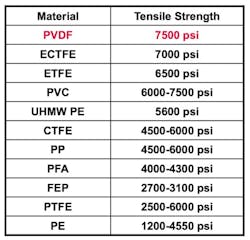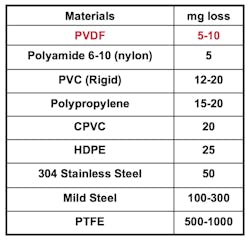PVDF offers solution for conveyor belt breakdowns
A need for safe processing equipment in the food processing industry is stemming from recent food recalls from plastic modular belting. Plastic contamination of food products is a critical issue and manufacturers worldwide are looking to combat the problem. Now more than ever, materials are needed that can withstand aggressive cleaning agents while still maintaining the mechanical and abrasion-resistant properties essential to thrive in a harsh processing environment.
Modular conveyor belts
Modular conveyor belting has faced scrutiny recently due to recalls of plastic belting breaking into food.1 The reasons behind these system failures can range from chemical attack leading to embrittlement, poor maintenance and worn-out components among other phenomena.2
Chemical attack is one of the main contributors to conveyor belt breakdown. Some of the harsh chemicals that cause modular failures include peroxyacetic acid (peracetic acid or PAA), bleaches and chlorines.3
Not all plastics are the same and polyvinylidene fluoride (PVDF) is an excellent material of choice for food conveying belts due to its robust chemical resistance to many harsh sterilization chemicals.⁴ PVDF is an upgrade to other plastics facing premature failures. Unlike metals or alloys, PVDF is a nonrusting polymer that maintains its high-purity characteristics throughout the life of the belt.
PVDF used in modular belting has no additives for performance and, thus, is used in many industries for high purity that require low extractables coming from the plastic parts. Some data suggests that certain PVDF grades will have lower extractable levels than metals commonly used in the market, allowing for pure food to be processed throughout the plant. It has been noted that using a pure PVDF material minimizes the risk of taste and flavor absorption.5
PVDF comes in a variety of melt viscosities and can be processed easily in molding and extrusion machines depending on the need of the part producer. Equipment used to process polyethylene and polypropylene can also be used to process PVDF into almost any part needed in the market space.6
Mechanical properties
PVDF has excellent mechanical property retention up to 302°F (150°C) compared to other plastic materials. Among the strongest fluoropolymers on the market, PVDF can be utilized in self-standing components, such as piping systems, pumps, conveyor beltings and any other melt-processable components. Table 1 shows the mechanical strength of PVDF.
PVDF is available in both rigid and flexible grades. Increased flexibility is attributed to manufacturing capabilities rather than additives or stabilizers.8 PVDF resin grades have flexural moduli ranging from 10,000 psi to 1,000,000 psi, allows flexible components such as tubing, gaskets, sheet linings, wire jacketing and stiff stock-shape components.
PVDF flexible tubing.
Chemical & permeation resistance
As a fluoropolymer, PVDF has excellent chemical resistance ranging from <1 to 13.5 pH, lending itself to common use with acids (nitric, phosphoric, citric, peroxyacetic), chlorine, bleach and many solvents. PVDF chemical resistance has been studied for many years and study results can be found in public literature. Furthermore, its polarity and crystalline structure make it one of the least permeable materials when compared to other plastics.
Table 1. Tensile strength of plastics, per ASTM D638. Source: Ultrapure Water (7)
Abrasion resistance
Since PVDF is a tough polymer, the abrasion resistance is higher than even some common metals utilized in the industry. PVDF may be rigid enough for self-standing components, but has low coefficient of friction, minimizing damage to food and beverage items during production. Table 2 compares various materials in abrasion resistance.
Flame & smoke properties
The recent increase in food processing plant fires has been a driving force in the search for materials that are more resistant to flame and smoke propagation.⁹ PVDF, with its history of use in wire and cable applications, has proven itself as an outstanding material for limiting damage from fire. With Limiting Oxygen Index (LOI) values ranging from 42 up to 100, PVDF contributes very little heat, greatly reducing the potential for flame spread. Furthermore, PVDF self-extinguishes once the direct flame source is removed. Certain grades of PVDF are ASTM E84 and UL723 (25/50)
compliant.
UV resistance
Since its commercialization more than 60 years ago, PVDF has been the choice of engineers and architects worldwide due to its long-term weathering
Table 2. Abrasion resistance of materials, mg/1,000 loss using a 1 kg load. Source: Ultrapure Water (7)
resistance in outdoor environments. Unlike traditional thermoplastics, PVDF resins do not need UV or thermal stabilizers. Instead, the inherent weathering is attributed to the backbone chemistry. For conveyor systems or components that are used outdoors, PVDF may be a reliable option.
Certifications & listings
PVDF resins are compliant with regulatory requirements in the food and beverage industries. See the list below:
National Sanitation Foundation (NSF) – NSF 51 and NSF 61
U.S. Food and Drug Administration (FDA) – 177.2510 & 177.2600 Repeated Contact with Food
3A Sanitary Standards (3-A SSI)
UL RTI – 150C Continuous Use rating
Certified Kosher by the Chicago Rabbinical Council
Summary
PVDF is a fluoropolymer with robust characteristics for the food and beverage industry. One of the most cost-effective, high-performance polymers, PVDF is utilized when commodity plastics have limited useful life. Furthermore, metal components often face premature failure due to corrosion. For plants aiming to maximize productivity, the inherent properties of PVDF offer improved assurance against failures associated with brittleness, chemical resistance or abrasion resistance.
References
- Whitworth, Joseph James. "Plastic or rubber-related recalls double-detectament." 2017. Food Quality News. https://www.foodqualitynews.com/Article/2017/01/13/Detectamet-Increased-recalls-could-be-due-to-more-monitoring
- "Causes of Conveyor Belt Downtime." 2016. Food Processing. http://www.fponthenet.net/article/127609/Causes-of-conveyor-belt-downtime.aspx
- Safefood 360. Cleaning and Disinfection in Food Processing Operations. 2012. http://safefood360.com/resources/Cleaning.pdf
- Pfuntner, A. 2011. Sanitizers and Disinfectants: The Chemicals of Prevention. Food Safety Magazine. August/September 2011. https://www.foodsafetymagazine.com/magazine-archive1/augustseptember-2011/sanitizers-and-disinfectants-the-chemicals-of-prevention/
- Witczak, Z. and Bielski, R. 2013 Clock Chemistry in Glycoscience: New Developments and Strategies. Pp 20. https://books.google.com/books?id=GLdkjgNsTiIC&dq=pvdf+taste+in+food&q=pvdf#v=snippet&q=pvdf&f=false
- Arkema Inc, Performance Data and Characteristics brochure, Pp 10-11. http://www.extremematerials-arkema.com/en/product-
families/kynar-pvdf-family/download-performance-characteristics-data-brochure/ - Hanselka, R., Williams, R., Bukay, M. 1987. Materials of Construction for Water Systems Part 1: Physical and Chemical Properties of Plastics. Ultrapure Water. July August 1987. Pp 46-50.
- Ellis, R. 1987. Sanitary Plastic Tubes. Food Processing. Pp 114-116.
- Jackson, M. 2017. Haltom City Firefighter Hospitalized Due to Overwhelming Smell at Food Plant. https://www.nbcdfw.com/news/local/Haltom-City-Firefighter-Hospitalized-Due-to-Ammonia-Smell-at-Food-Plant-410380535.html
Averie Palovcak graduated with a Bachelor of Science and Master of Science in biomedical engineering from Drexel University. Palovcak currently works for Arkema as an applications engineer for the Technical Polymers Division.
Jason Pomante graduated from Lafayette College with a Bachelor of Science in chemical engineering and MBA from Saint Joseph’s University. Pomante has worked at Arkema for 15 years and is currently the North American market manager in the Technical Polymers Division.







